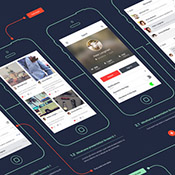
So you have decided to use external provider to build you a website. There are thousands of reasons for people to use outsourcing but we will not go over them as it is a subject for a whole book. The point is you’ve made a decision to look for a development team overseas. But how do you find a reliable partner who totally gets the needs and requirements of your business somewhere in a far away country?
The following 11 steps will make this process easier for you.
Step 1: Decide what you want. You are probably thinking: “I know what I want. I want a nice, good-looking website.” But it isn’t as easy as it looks. What kind of website are you looking for? Is it a simple corporate website for your start-up with a couple of pages, text blocks and pictures? Or is it an online-store for your hand-made jewelry? Or maybe it is a comprehensive online inventory system for your warehouse? Are you planning to add just a few products each month to your website or would you like to upload a whole database? Would you like to get statistics about your website visits? Make sure you understand exactly what you are looking for as all the further steps depend upon the decisions made here, in Step 1
Step 2: Prepare a list.  Surf the web and make a list of websites that have a functionality set similar to the one you need. Make notes of the features you especially like. Finished? Now surf the web again but this time pay attention to design. Make a list of wed-designs that you like and, more importantly, the one’s that you don’t like. “Why?” you ask. Because it is important for a designer to know that you don’t like some particular color or layout so he/she will not use it for your website.
Surf the web and make a list of websites that have a functionality set similar to the one you need. Make notes of the features you especially like. Finished? Now surf the web again but this time pay attention to design. Make a list of wed-designs that you like and, more importantly, the one’s that you don’t like. “Why?” you ask. Because it is important for a designer to know that you don’t like some particular color or layout so he/she will not use it for your website.
Step 3: Set your budget. Now that you know what kind of website you are looking for it is time to set your budget. Although making a web-site via outsourcing will probably turn out to be cheaper than actually hiring someone, remember that people in other countries do not work for free. Let’s say it will take 40 hours to create a perfect website for you. Is it possible that it would cost $40? Unfortunately not. And keep in mind that price is quality. The better quality you want your web-site to be the more it would cost.
Step 4: Make a research.  Start by researching the market, see what kind of companies are out there. Besides the good old Google search you can also use websites such as Elance or oDesk. Don’t judge the companies by their geographical location. Remember: there are professionals everywhere. Look at their experience. Make a list of companies that have a more or less relevant experience. Don’t only choose big companies. If your web-site is rather simple it would be better to use small or middle size teams. They will be dedicated to your project and will probably cost less. If you are having a hard time finding an outsourcing provider on your own you can always turn to an independent consultant or a consulting agency for help.
Start by researching the market, see what kind of companies are out there. Besides the good old Google search you can also use websites such as Elance or oDesk. Don’t judge the companies by their geographical location. Remember: there are professionals everywhere. Look at their experience. Make a list of companies that have a more or less relevant experience. Don’t only choose big companies. If your web-site is rather simple it would be better to use small or middle size teams. They will be dedicated to your project and will probably cost less. If you are having a hard time finding an outsourcing provider on your own you can always turn to an independent consultant or a consulting agency for help.
Step 5: Contact your candidates. It’s time to make your first move. Contact your potential candidates via e-mail. Let them know about what you are looking for (and this is what Step 1 and Step 2 are for), your budget expectations (Step 3 comes in handy here). Ask them to provide samples of their work that could be relevant to your project. And of course ask if they can provide feedback.
Step 6: Look at portfolios. Check out those websites the companies have in their portfolios. But don’t pay too much attention to design. As the old saying goes “don’t judge the book by its cover”. Try actually using those websites. Click on every page, register, contact administrator etc. The website should be fully functional. Even the best looking design will not save a website that doesn’t work properly from disaster.
Step 7: Ask for feedback.  Don’t be afraid to spend a lot of time on this step. Contact people who have already worked with your potential candidates and ask them about their experience. Try contacting those who had projects similar to yours. Are they happy with the quality of work? Were they comfortable working with the team? Was all the work done in time? What overall impression do they have about the team?
Don’t be afraid to spend a lot of time on this step. Contact people who have already worked with your potential candidates and ask them about their experience. Try contacting those who had projects similar to yours. Are they happy with the quality of work? Were they comfortable working with the team? Was all the work done in time? What overall impression do they have about the team?
Step 8: Call them. Don’t hesitate to call before signing the contract. Talk to the manager who is going to be your ‘contact’ person throughout the whole project duration. Make sure communications with your team representative are clear and you understand each other quickly. Go over the project milestones one more time to make sure you are on the same page with the manager.
Step 9: Give a test task.  Don’t be afraid to ‘test’ your candidates. Give them a test task. It will work as a pilot project for you. You will be able to see whether the team understands your requirements, whether it can meet deadlines, whether it can deliver the proper level of quality etc. If a candidate doesn’t want to do a test task, cross him out of your list. Keep in mind that normally a test task is paid for but it will be money well spent. It is better to pay $500 for a test task and make sure that the team is right for you than hire an unreliable team and spend $5000 on a poor quality website.
Don’t be afraid to ‘test’ your candidates. Give them a test task. It will work as a pilot project for you. You will be able to see whether the team understands your requirements, whether it can meet deadlines, whether it can deliver the proper level of quality etc. If a candidate doesn’t want to do a test task, cross him out of your list. Keep in mind that normally a test task is paid for but it will be money well spent. It is better to pay $500 for a test task and make sure that the team is right for you than hire an unreliable team and spend $5000 on a poor quality website.
Step 10: Analyze. It is time to analyze all the information you gathered. The easiest way to do that is to jot down a list of pros and cons of each candidate. Give some extra credit to those who have suggested interesting solutions for your project. Compare the offers you received to your budget expectations. Keep in mind that if most of the offers exceed your budget expectations it probably means that you underestimated your project complexity. In this case it is better to either expand your budget or simplify your requirements.
Step 11: Make a decision. Here is a short checklist for you to go over before you make your final decision:
-
Was all the feedback you received about the candidate convincing?
-
Was the test task done properly?
-
Were you comfortable with how the team worked with during project discussion stage?
If the answer to these questions is “Yes” then you can go ahead and sign a contract.
Good luck!





